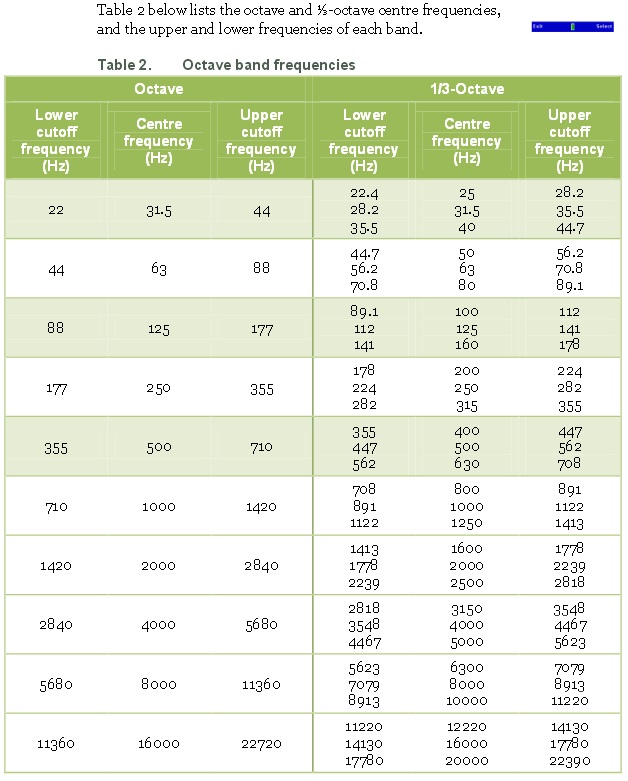http://noisetestingequipment.com/one-third-octave-band-analyzer/
A One-third Octave Band AnalyzerMeasures Sound Levels for Detailed Analysis.[backcolor=rgba(255, 255, 255, 0.3)]While lower tier sound level meters and dosimeters are noise testing equipment that provides information routinely used in sound monitoring programs by engineers, physicists, industrial hygienists, medical personal, and field monitoring personnel, a one-third octave band analyzer or 1/3 octave band analyzer provides sound level analysis with greater detail. This detail is often required to assist with determining sound pressure levels associated with the frequency content of the noise or sound. Sound pressure is seldom the same for all frequencies.[backcolor=rgba(255, 255, 255, 0.3)]Thus, it is often important to measure the sound pressure level as it varies with frequency. Post processing sound pressure records in an office can generally produce a plot of the sound pressure versus frequency for almost any range of frequencies and with as much detail as the analyst needs. In general, this much detail is not required; therefore, a more sophisticated sound level meter that differentiates sound pressure with frequency (sound level analyzer) is designed with preset frequencies that range between 20 and 20,000 Hz. Since this is a very large range of frequencies, it is convenient to divide the range of values into smaller segments. [backcolor=rgba(255, 255, 255, 0.3)] Casella Cel633 C Real time third octave band analyzer
For example, sound pressures may be calculated for 10 windows,[backcolor=rgba(255, 255, 255, 0.3)]starting with 31.5 Hz. Each window represents a spread of values. Here, a center frequency of 31.5 Hz represents a window of values between 22 and 44 Hz. Starting with 31.5 Hz and doubling the value 10 times yields, 31.5, 63, 125, 250, 500, 1000, 2000, 4000, 8000, and 16000 Hz. This is called an octave band representation of the results, because it doubles each time. The Table 2 chart below from Casella Cell shows the range of values for each frequency, more specifically each center frequency. For even greater detail, each range of values can be divide in to smaller groups of three windows per octave. When the results are presented with three ranges of values per octave, the results are called 1/3 octave band or one-third octave band results.
OSHADefines Octave bands:[backcolor=rgba(255, 255, 255, 0.3)]Sounds that contain energy over a wide range of frequencies are divided into sections called bands, each one octave. A common standard division is in 10 octave bands identified by their center frequencies, 31.5; 63; 250; 500; 1,000; 2,000; and 4,000 Hz. For each octave band, the frequency of the lower band limit is one‐half the frequency of the upper band limit. This is the most common type A-4 of frequency analysis performed for workplace exposure evaluation and control. An alternative frequency band, the one‐third octave band, is defined as a frequency band such that the upper bandedge frequency, f2, is the cube root of two times the lower band frequency, f1: f2 = (2)1/3 f1. [backcolor=rgba(255, 255, 255, 0.3)]The agency also points out that “The American Conference of Governmental Industrial Hygienists (ACGIH®) has established permissible ultrasound exposure levels. These recommended limits (set at the middle frequencies of the one‐third octave band analyzer is from 10 kHz to 100 kHz) are designed to prevent possible hearing loss caused by the subharmonics of the set frequencies, rather than the ultrasound itself. These exposure levels represent conditions under which it is believed that nearly all workers may be repeatedly exposed without adverse effects on their ability to hear and understand normal speech….offers recommendations for measuring or verifying ultrasound levels, which requires a precision sound level meter equipped with a suitable microphone of adequate frequency response and a third‐octave filter. CSHOs considering evaluating ultrasound levels should consult the CTC for assistance in selecting a suitable instrument.”
[backcolor=rgba(255, 255, 255, 0.3)] Octave band analyzer and 1/3 octave band analyzer settings from Casella Cel
|